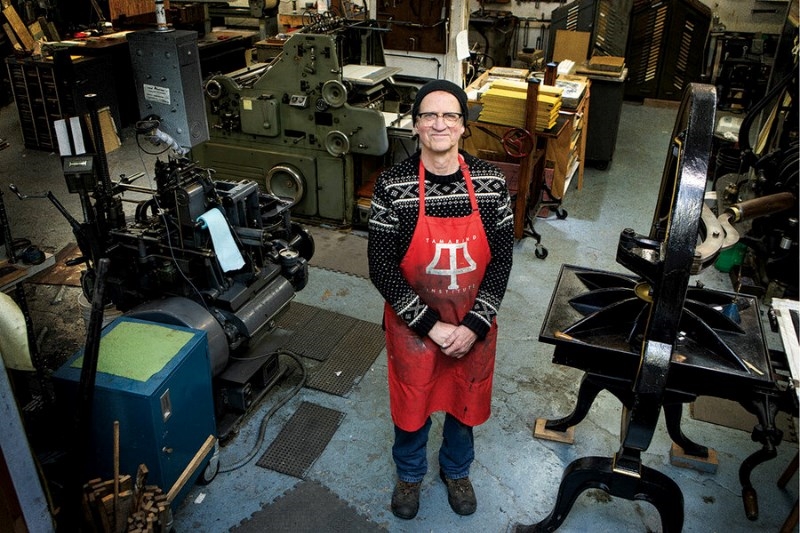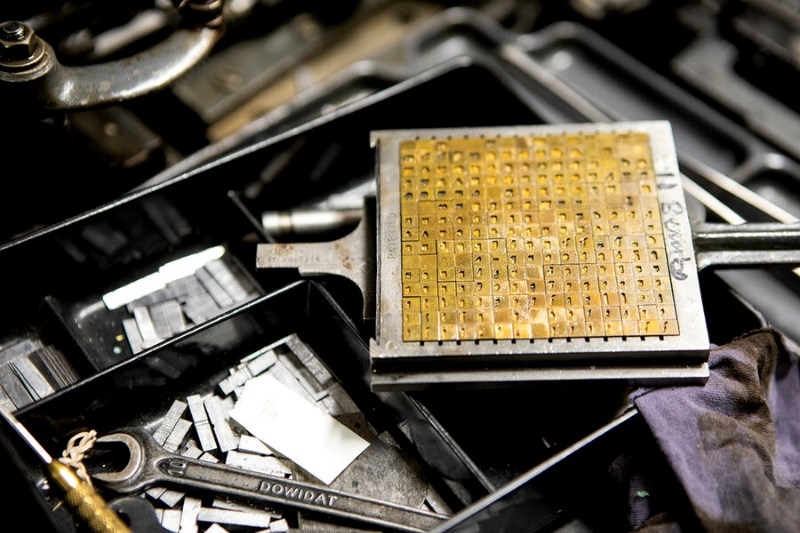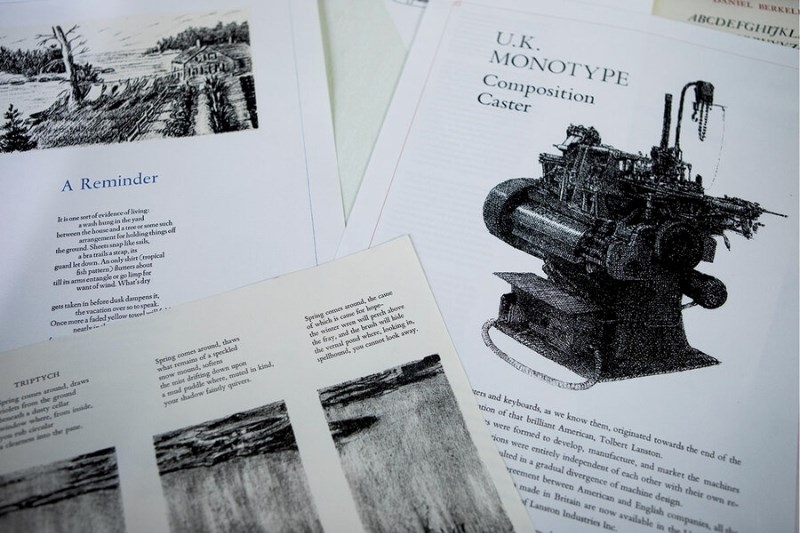REPRINTED WITH PERMISSION FROM THE CHRISTIAN SCIENCE MONITOR
Much is made of the creative possibilities that artificial intelligence will unlock. But in Maine, one man uses centuries-old technology to satisfy modern sensibilities.
 David Wolfe stands with his working letterpress machines at Wolfe Editions, in Portland, Maine, Nov. 1. They include a Tufts iron hand press from the mid-1800s (right), an Intertype composition caster machine from the 1950s (left), and an Italian Nebiolo cylinder letterpress from 1958 (back left). Melanie Stetson Freeman/Staff
David Wolfe stands with his working letterpress machines at Wolfe Editions, in Portland, Maine, Nov. 1. They include a Tufts iron hand press from the mid-1800s (right), an Intertype composition caster machine from the 1950s (left), and an Italian Nebiolo cylinder letterpress from 1958 (back left). Melanie Stetson Freeman/Staff
|PORTLAND, MAINE - Visitors to David Wolfe’s printing shop in Portland, Maine, can’t miss the statuesque Civil War-era Tufts hand-press machine that stands tall near the front door. It exited that same door several years ago, headed for a movie set.
For its cameo in the 2019 film, his “‘Little Women’ machine,” as he calls it, was hauled down to Massachusetts. Mr. Wolfe accompanied it, dressed in 1860s costume for his role as the printer of Jo March’s book. Yet as he recalls, laughing, “Only my hands made the cut.”
Wolfe Editions is a place buzzing with activity. The master printmaker and fine artist treasures his many letterpress machines not only for their place in history, but also for their ability to help him craft exquisitely beautiful books, prints, posters, and more. They are essential tools for daily production, ones that stand out in an ever more high-tech world.
Rather than using bits and bytes, Mr. Wolfe prints just as Johannes Gutenberg did when he developed the process of letterpress printing in the 15th century to make his famous Bible: Letters are cast in lead, then locked together, inked, and pressed into paper.
“The computer didn’t kill my business. It made it stronger,” he says, noting that he’s also benefited from recent interest in the lost art of letterpress printing. “The product I make is high end, and computers took over all the other stuff. A finely printed book is a beautiful object and a reminder of the past when books were vital keepers of information.”
 Melanie Stetson Freeman/StaffMaster printmaker David Wolfe's workspace includes a Monotype composition matrix case, which houses the complete set of alphabet matrices used to cast letters.
Melanie Stetson Freeman/StaffMaster printmaker David Wolfe's workspace includes a Monotype composition matrix case, which houses the complete set of alphabet matrices used to cast letters.
A man and his machines
Mr. Wolfe typically juggles several projects at once. On a recent afternoon, he has just paused production of an edition of John Steinbeck’s “Of Mice and Men” while waiting for a shipment of handmade paper. He’s using the time instead to create designs for one son’s new canned cocktails company (his other son is a printer). He’s also teaming up with artist and friend Charlie Hewitt to design a poster commemorating the anniversary of Muhammad Ali’s fight in Lewiston, Maine.
Mr. Hewitt has known Mr. Wolfe for 20 years, has collaborated with him on multiple projects, and happens to have a studio right next door. He says it’s important to the printmaker to pass down the old techniques to a new generation. “He is always training and teaching others. He is incredibly generous, remarkably skilled, and brings so much to every medium,” Mr. Hewitt adds.
A well-received exhibit at Moss Galleries – in nearby Falmouth, Maine – of Mr. Wolfe’s abstract, mixed-media works wrapped up recently. He’s already dreaming up more solo and collaborative projects, among them books with his own fine-art imagery and more “broadsides,” which are one-sided, flat sheets with both text and illustration.
“What he’s done with his new work is so courageous,” Mr. Hewitt says. “He is extremely versatile. He can work with both a 17th-century press and a 21st-century printer.”
Mr. Wolfe’s letterpress and hot-metal casting machines, about 10 in all, fill his spacious shop – a former bakery. Despite their age and frequent use, the devices appear impeccably cared for. (Some are undergoing renovations off-site.)
Each one has a story, which he delights in sharing: He acquired his beloved Monotype machine in 2005 to add to his growing business; he and his son schlepped an Italian Nebiolo cylinder-press machine cross-country from San Francisco; and there’s also the Intertype machine, which he explains revolutionized printing and the spread of information with its speed.
Not only is he passionate about his work, but it suits him. “Letterpress printing couldn’t be more tedious,” he says. “But I like tedium. I have the patience for it.”
Mr. Wolfe often works alone – to the sound of “bluegrass, jazz, reggae, classical, or the ’70s rock I grew up on,” he says.
Lately he’s been mentoring an apprentice, a student from nearby Maine College of Art & Design, who shares his taste in music and also for tedium. “I’ll ask Claire to put away the type,” he says, “and she’ll respond, ‘Oh, I love putting away type!’”
His influence is also felt beyond his shop’s doors.
During the past 11 years, Nicole Manganelli of Portland has taken many of Mr. Wolfe’s letterpress-printing workshops. “His warm and generous teaching is a huge part of why I have continued to come back,” she says. “Although I have tried other printmaking methods, letterpress printing is the one that holds my heart – and David’s mentorship is a big reason for that.”
 Melanie Stetson Freeman/StaffIn his Maine shop, master printmaker David Wolfe uses machines from bygone eras to create a variety of items.
Melanie Stetson Freeman/StaffIn his Maine shop, master printmaker David Wolfe uses machines from bygone eras to create a variety of items.
“It’s all a collaboration”
Mr. Wolfe has taught at schools in Maine including Bowdoin College, Haystack Mountain School of Crafts, and Gould Academy. He’s also shared his expertise further afield, at Dartmouth College in New Hampshire and Penland School of Craft in North Carolina.
He most enjoys the workshop format, for its small size and short duration. “It’s more intense when you have to cover a lot in a short amount of time, and students in workshops are typically motivated and excited about learning.” He considers his students almost like partners in the printmaking process. “It’s all a collaboration,” he says. “I’m just the leader.”
Mr. Hewitt recalls a project he and Mr. Wolfe worked on together: the illuminated neon “Hopeful” sign mounted in 2019 on the roof of Speedwell Projects, a nonprofit gallery in Portland. “I wanted to use the word ‘Hopeful,’ and I scribbled it on paper for David,” he explains. “I needed a master printer to facilitate the process and create the font.”
Mr. Hewitt says he was elated with the design – inspired by the building’s history as an auto dealership, typeface from the badge of a 1940s Packard, and his own love for 1960s counterculture. He adds with a laugh, “If it was up to me, I might have just used Helvetica.”
For his part, Mr. Wolfe relishes collaborations like that one: the process of give and take, the creative energy, the mutual admiration. Or as he puts it, “I enjoy helping people realize their ideas. It broadens my scope, and artists are pushing the mediums beyond what they were using before. So that’s always exciting to me.”
After 40 years, he’s content to have arrived at a place in his career where he’s teaming up with a variety of artists whose work he finds inspiring and engaging. He’s also glad to be creating more of his own original designs. One way or the other, he says with a smile, “I make art every day.”
Related stories
Page created on 12/18/2023 5:12:08 PM
Last edited 12/18/2023 6:29:33 PM
